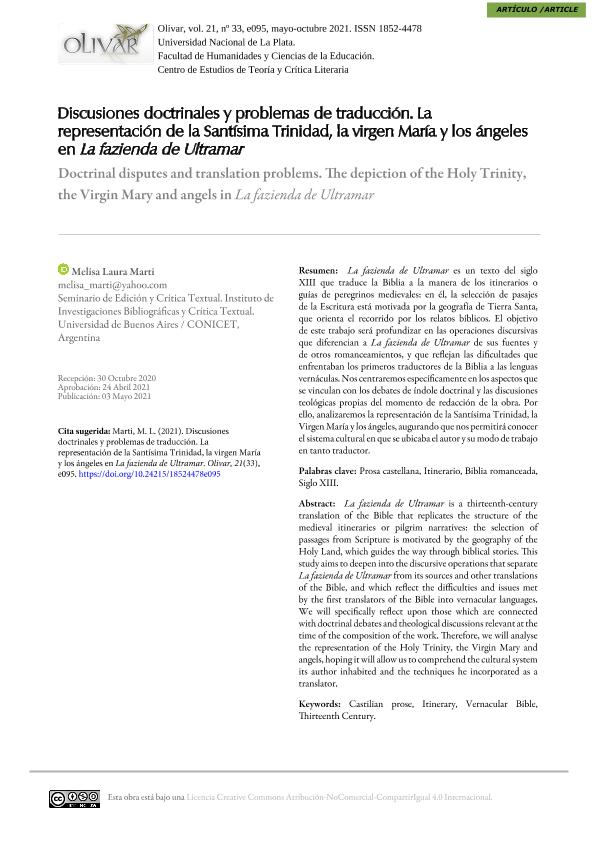Mostrar el registro sencillo del ítem
dc.contributor.author
Marti, Melisa Laura

dc.date.available
2022-10-06T12:46:32Z
dc.date.issued
2021-05
dc.identifier.citation
Marti, Melisa Laura; Discusiones doctrinales y problemas de traducción: La representación de la Santísima Trinidad, la Virgen María y los ángeles en La fazienda de Ultramar; Universidad Nacional de La Plata. Facultad de Humanidades y Ciencias de la Educación; Olivar; 21; 33; 5-2021; 1-11
dc.identifier.issn
1852-4478
dc.identifier.uri
http://hdl.handle.net/11336/172171
dc.description.abstract
La fazienda de Ultramar es un texto del siglo XIII que traduce la Biblia a la manera de los itinerarios o guías de peregrinos medievales: en él, la selección de pasajes de la Escritura está motivada por la geografía de Tierra Santa, que orienta el recorrido por los relatos bíblicos. El objetivo de este trabajo será profundizar en las operaciones discursivas que diferencian a La fazienda de Ultramar de sus fuentes y de otros romanceamientos, y que reflejan las dificultades que enfrentaban los primeros traductores de la Biblia a las lenguas vernáculas. Nos centraremos específicamente en los aspectos que se vinculan con los debates de índole doctrinal y las discusiones teológicas propias del momento de redacción de la obra. Por ello, analizaremos la representación de la Santísima Trinidad, la Virgen María y los ángeles, augurando que nos permitirá conocer el sistema cultural en que se ubicaba el autor y su modo de trabajo en tanto traductor.
dc.description.abstract
La fazienda de Ultramar is a thirteenth-century translation of the Bible that replicates the structure of the medieval itineraries or pilgrim narratives: the selection of passages from Scripture is motivated by the geography of the Holy Land, which guides the way through biblical stories. This study aims to deepen into the discursive operations that separate La fazienda de Ultramar from its sources and other translations of the Bible, and which reflect the difficulties and issues met by the first translators of the Bible into vernacular languages. We will specifically reflect upon those which are connected with doctrinal debates and theological discussions relevant at the time of the composition of the work. Therefore, we will analyse the representation of the Holy Trinity, the Virgin Mary and angels, hoping it will allow us to comprehend the cultural system its author inhabited and the techniques he incorporated as a translator.
dc.format
application/pdf
dc.language.iso
spa
dc.publisher
Universidad Nacional de La Plata. Facultad de Humanidades y Ciencias de la Educación

dc.rights
info:eu-repo/semantics/openAccess
dc.rights.uri
https://creativecommons.org/licenses/by-nc-sa/2.5/ar/
dc.subject
PROSA CASTELLANA
dc.subject
ITINERARIO
dc.subject
BIBLIA ROMANCEADA
dc.subject
SIGLO XIII
dc.subject.classification
Literaturas Específicas

dc.subject.classification
Lengua y Literatura

dc.subject.classification
HUMANIDADES

dc.title
Discusiones doctrinales y problemas de traducción: La representación de la Santísima Trinidad, la Virgen María y los ángeles en La fazienda de Ultramar
dc.title
Doctrinal disputes and translation problems: The depiction of the Holy Trinity,
the Virgin Mary and angels in La fazienda de Ultramar
dc.type
info:eu-repo/semantics/article
dc.type
info:ar-repo/semantics/artículo
dc.type
info:eu-repo/semantics/publishedVersion
dc.date.updated
2022-09-16T10:30:51Z
dc.journal.volume
21
dc.journal.number
33
dc.journal.pagination
1-11
dc.journal.pais
Argentina

dc.journal.ciudad
La Plata
dc.description.fil
Fil: Marti, Melisa Laura. Consejo Nacional de Investigaciones Científicas y Técnicas. Oficina de Coordinación Administrativa Saavedra 15. Instituto de Investigaciones Bibliográficas y Crítica Textual; Argentina
dc.journal.title
Olivar
dc.relation.alternativeid
info:eu-repo/semantics/altIdentifier/url/https://www.olivar.fahce.unlp.edu.ar/article/view/olie095
Archivos asociados
